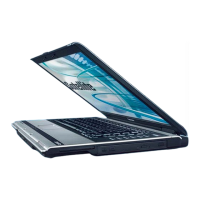50
Disposing of used batteries safely
5.375 x 8.375 ver 3.1
4 Connect the AC adapter to the computer and the power cable to a
power outlet. The DC-IN (if applicable to your system) or AC
power light should glow green, and the battery light should glow
amber to indicate that the battery is being charged. If the DC-IN
or AC power light indicator does not glow, power is not being
supplied. Check the connections to the AC adapter and power
cable.
5 Charge the battery until the battery light glows green.
❖ If you have extra batteries, rotate their use.
❖ If you will not be using the system for an extended period (more than
one month), remove the battery.
❖ Disconnect the AC adapter when the battery is fully charged.
Overcharging makes the battery hot and shortens life.
❖ If you are not going to use the computer for more than eight hours,
disconnect the AC adapter.
❖ Store spare batteries in a cool dry place out of direct sunlight.
Disposing of used batteries safely
The life of a battery pack should last for years. When the battery pack
needs replacing, the main battery light flashes amber shortly after you have
fully recharged the battery
.
You must discard a battery if it becomes damaged.
The computer’s main battery is a Lithium Ion (Li-Ion) battery, which can
explode if not properly replaced, used, handled, or disposed of. Putting
spent batteries in the trash is not only irresponsible, it may be illegal.
Dispose of the battery as required by local ordinances or regulations.
Use only batteries recommended by Toshiba.
After repeated use, the batteries will finally lose their ability to hold a
charge and you will need to replace them. Under federal, state and local
laws, it may be illegal to dispose of old batteries by placing them in the
trash.
Please be kind to our shared environment. Check with your local
government authority for details regarding where to recycle old batteries or
how to dispose of them properly. If you cannot find the information you
need elsewhere, call Toshiba at: 1 (800) 457-7777.
Important information about your CPU cooling fan
The round cooling fan on the underside of your computer keeps the central
processing unit at a temperature suitable for optimum performance by
drawing outside air into the computer.

